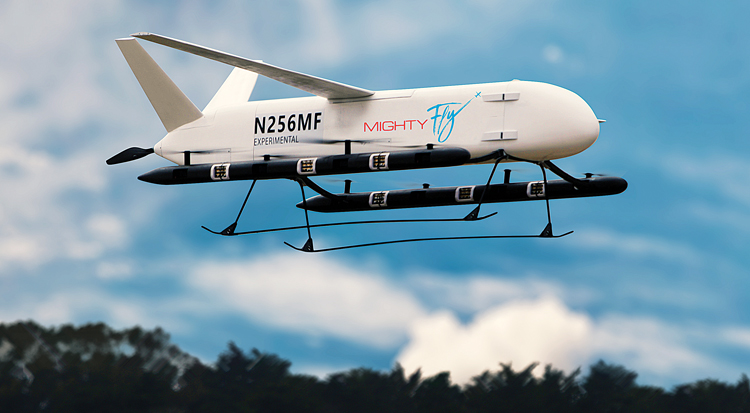Innovations to Revolutionise Air Freight
The development of autonomous air cargo solutions opens a treasure trove of opportunities with the potential to reshape the landscape of global logistics

The skies are no longer just for passenger planes. A revolution is brewing in the air cargo industry, with companies developing solutions for autonomous delivery of goods. These innovative players aim to transform logistics, offering faster, cheaper, and more sustainable transportation options. Traditionally dominated by passenger flights, the airspace is now becoming a frontier for innovative companies pioneering autonomous delivery solutions.
These autonomous delivery solutions promise a multitude of advantages, with speed, cost-effectiveness, and sustainability at the forefront. The implementation of such technologies aims to streamline the logistics process, offering faster delivery times that can significantly benefit various industries. The reduced need for human intervention also contributes to cost savings, making these solutions more economically viable in the long run.
In addition to the economic advantages, the integration of autonomous air cargo solutions addresses environmental concerns by providing a more sustainable alternative to traditional transportation methods. Electric-powered drones and other ecofriendly technologies are being incorporated into these systems, contributing to a reduced carbon footprint compared to conventional cargo planes or ground transportation.
Regulatory frameworks are adapting to accommodate these advancements, with aviation authorities worldwide working to establish guidelines and standards for the safe integration of autonomous cargo flights into airspace. This regulatory evolution is a crucial aspect of ensuring the responsible deployment of these technologies.
EXCITING OPPORTUNITIES
The development of autonomous air cargo solutions brings forth numerous exciting opportunities, poised to revolutionise the logistics landscape across various key areas. Firstly, in terms of speed and efficiency, drones have the potential to significantly reduce delivery times by bypassing congested ground routes and efficiently navigating through airspace. This capability is particularly beneficial for time-sensitive goods such as medical supplies, fresh produce, and critical industrial components. Moreover, the use of autonomous drones can enhance access to remote areas, reaching places like mountainous regions, islands, and disaster zones for faster delivery of essential goods and humanitarian aid. The dynamic route planning and on-demand scheduling capabilities of drones also offer the opportunity to optimise delivery networks, increasing overall efficiency and reducing transportation costs.
In terms of cost-effectiveness and sustainability, the adoption of autonomous air cargo solutions presents various advantages. While the initial investment may be high, long-term operational costs can be lower, with the elimination of pilot salaries and associated training costs, optimisation of fuel consumption compared to traditional air cargo planes, and reduced maintenance requirements of simpler drone designs. The environmental benefits of electric and hybrid-powered drones include quieter operation and lower emissions, contributing to a more sustainable future for logistics. Additionally, the affordability of air cargo solutions can open up new markets for small and medium enterprises in remote regions, fostering global trade and economic growth.

Unlocking new business models and services is another exciting aspect of autonomous air cargo. Drones enable on-demand, instant delivery of essential goods for local communities, creating new business opportunities for retailers and service providers. Specialised delivery solutions can be tailored to specific industries with niche needs, such as transporting medical samples, delivering valuable artwork, or providing emergency response services. Real-time data collected by drones can be leveraged for data-driven logistics, optimising supply chains, predicting demand, and improving overall efficiency.
Furthermore, the development of autonomous air cargo is set to boost innovation and collaboration. The demand for such solutions will drive technological advancements in areas like battery technology, sensor fusion, and artificial intelligence, benefiting industries beyond logistics. Collaboration between startups, established logistics companies, aerospace manufacturers, and research institutions is crucial for driving innovation and realising the full potential of this technology. The global impact of efficient and affordable air cargo solutions extends to contributing to global economic development by connecting remote communities, facilitating international trade, and enhancing overall supply chain resilience.
CHALLENGES GALORE
The landscape of autonomous air cargo solutions is riddled with a myriad of challenges, each requiring careful consideration for the successful integration of this innovative technology. Regulatory uncertainties pose a significant hurdle, with unclear rules and regulations surrounding unmanned aerial vehicles (UAVs), particularly for larger cargo drones. This lack of clarity creates uncertainty for companies regarding airspace access, operational restrictions, and certification requirements. Additionally, the slow pace of regulatory updates and differing regulations across countries further complicate cross-border operations, necessitating complex compliance efforts.
Safety concerns add another layer of complexity, as worries persist about potential collisions with other aircraft, buildings, or people. Reliable collision avoidance systems utilising LiDAR, radar, and advanced algorithms become crucial, along with comprehensive emergency protocols to address situations like engine failure, battery malfunctions, or cyberattacks. Cybersecurity threats pose a specific risk, with the vulnerability of autonomous drones to malicious attacks that could compromise flight control systems or manipulate data. Robust cybersecurity measures and secure communication protocols are imperative to safeguard operations.
Technological limitations, such as battery and sensor constraints, need to be overcome for the full potential of autonomous air cargo to be realised. Current battery technology restricts range and payload capacity, demanding advancements for extended flight times and heavier cargo deliveries. Improved sensor capabilities are necessary for reliable navigation and obstacle avoidance in challenging environmental conditions. While autonomous flight systems are progressing, further automation efforts are required for truly autonomous end-to-end operations.
Infrastructure bottlenecks pose practical challenges, with a lack of dedicated landing and take-off infrastructure limiting convenient access for cargo loading and unloading. Efficient ground handling procedures, along with automated systems and standardised protocols, need to be established. Compatibility with existing airport and logistics infrastructure is crucial for seamless integration, requiring standardised communication protocols and data exchange formats for coordinated operations.
The integration with existing systems, including air traffic control and logistics management platforms, demands efficient communication and compatibility. Security protocols must align with existing transportation and aviation security measures to ensure cargo safety and prevent unauthorised access.

(Right) Reliable Robotics demonstrates uncrewed flight of a large cargo aircraft.
The economic viability of autonomous air cargo is a central concern, given the high initial investment required for research, development, manufacturing, and infrastructure. Optimising operational costs becomes essential for competing with established and cheaper transportation options, necessitating considerations such as battery charging, maintenance, and airspace fees. Identifying revenue streams and building sustainable business models beyond offering faster delivery at a premium is crucial for long-term success.
Weather dependence introduces an additional layer of complexity, with adverse weather conditions impacting drone operations and potentially causing delays or cancellations. Developing weather-resistant technology, robust flight planning algorithms, and real-time weather forecasting capabilities are crucial for reliable delivery performance. Also, the overarching cybersecurity threats, encompassing vulnerability to cyberattacks and data security concerns, underscore the need for robust cybersecurity measures, encrypted communication protocols, and the development of cyber resilience strategies.
Autonomous delivery solutions offer advantages such as speed, cost-effectiveness, and sustainability by streamlining logistics, reducing human intervention, and incorporating eco-friendly technologies like electric-powered drones
Public acceptance emerges as a multifaceted challenge, with varying attitudes towards drone technology, concerns about noise pollution, privacy, and safety potentially hindering widespread adoption. Public education and communication campaigns are crucial for generating understanding, addressing anxieties, and highlighting the potential benefits of autonomous air cargo.
By acknowledging and addressing these numerous challenges, stakeholders in autonomous air cargo can pave the way for a future where this innovative technology revolutionises global goods movement, delivering on its promise of speed, efficiency, and sustainability.
LEADING THE CHARGE
In the realm of autonomous air cargo delivery, several companies are at the forefront, pioneering innovative technologies and achieving significant milestones. Dronamics is on a mission to change the way the world thinks about cargo delivery and are building an air cargo ecosystem to serve the needs of people and industries in all corners of the planet. A mobility solution powered by long-range cargo drones that saves time, costs and carbon emissions.
Taking a distinctive approach, Natilus focuses on the development of autonomous cargo seaplanes. Operating at low altitudes, these amphibious drones present the potential to navigate regulatory challenges more seamlessly. Natilus sets itself apart with a hybrid-electric propulsion system, ensuring quieter and more environmentally friendly operations. The company’s commitment to innovation is reflected in its pursuit of unconventional solutions for the autonomous cargo delivery landscape.
Elroy Air, a Silicon Valley startup, specialises in the design and construction of autonomous vertical take-off and landing (VTOL) aircraft tailored specifically for cargo delivery. The Condor drone, a creation of Elroy Air, boasts an impressive capacity to carry up to 500 pounds over distances exceeding 300 miles. This capability positions it as an ideal solution for short-haul and middle-mile logistics, contributing to the advancement of efficient and autonomous cargo transportation.
Zipline, renowned for its expertise in medical drone deliveries, is expanding its footprint in the broader air cargo market. Operating fixed-wing drones in Rwanda and Ghana, Zipline has successfully delivered critical supplies such as blood and vaccines. Leveraging their proficiency in long-range autonomous flight, Zipline is poised to play a pivotal role in the broader application of cargo delivery, emphasising the potential for transformative impact beyond medical logistics.
One notable player in this space is Xwing, a California-based company that has positioned itself as a leader in the development of autonomous cargo aircraft. Xwing’s groundbreaking “Superpilot” system stands out for its ability to retrofit existing planes, such as the Cessna 208B Grand Caravans, enabling them to fly autonomously. In a monumental achievement in 2021, Xwing successfully executed the world’s first autonomous gate-to-gate cargo flight, showcasing the practical application and viability of their cutting-edge technology.

(Right) Natilus Says New Autonomous Aircraft To Enhance Rapid and Safe Logistics in Africa.
Embark Aeronautics, an Israeli company, introduces a modular approach to autonomous cargo delivery. Their innovative design focuses on interchangeable cargo pods that can be attached to various aircraft types. This adaptability not only enhances versatility but also allows them to cater to different needs and payload capacities, making their system potentially more flexible for diverse logistics operations.
In addition to individual efforts, collaborations and partnerships are integral to advancing autonomous air cargo technology. Boeing and Kitty Hawk, through their joint venture, are actively developing electric VTOL aircraft for urban air mobility, a technology that could extend its applications to air cargo delivery. Airbus and Deutsche Post DHL are collaborating on the “AirMule” project, exploring the use of drones specifically for delivering urgent and time-sensitive cargo. As companies collaborate, compete, and learn from each other, the technology will evolve at an incredible pace. Governmental agencies like NASA and the FAA in the United States are actively involved in shaping the regulatory landscape and safety protocols for autonomous flight. Their contributions are essential for ensuring the safe and widespread adoption of this transformative technology.
As various companies and collaborative efforts continue to push the boundaries of autonomous air cargo delivery, the industry stands on the cusp of a revolutionary transformation, with the potential to reshape the future of logistics on a global scale.
CONCLUSION
This is just a glimpse into the exciting world of autonomous air cargo. The ongoing revolution in the air cargo industry driven by autonomous delivery solutions is reshaping the landscape of logistics. With companies investing in cutting-edge technologies and regulatory bodies adapting to the changing dynamics, the skies are poised to become a bustling domain for autonomous cargo transportation, offering faster, cheaper, and more sustainable options for the movement of goods. The implications of this transformation extend beyond just business efficiency, influencing global supply chains, environmental impact, and the accessibility of essential services in remote areas.
The autonomous air cargo industry is still in its early stages, but the potential is undeniable. Continued innovation, collaboration, and regulatory progress, will revolutionise the way these flying machines move goods in the years to come. As the technology matures, it will be fascinating to see how these companies adapt and evolve, shaping the future of logistics and creating a truly interconnected and efficient global supply chain. The future of logistics is taking flight, and it’s going to be a wild ride!





